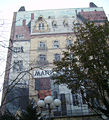Hemshof
|
|||
|---|---|---|---|
| coat of arms | map | ||

|

|
||
| Data | |||
| Area : | 1.58 km² | ||
| Residents : | 16,639 | ||
| Population density : | 10,531 inhabitants / km² | ||
| Postal code : | 67063 | ||

The Hemshof is a district of Ludwigshafen am Rhein . Together with the north and west districts, it forms the northern inner city district . It is characterized by the combination of the German old town and various foreign cultures.
Hemshof - like the districts of Oggersheim , Mundenheim , Maudach and Friesenheim - was first mentioned in a document in the Lorsch Codex in 770 , and there a further four times in the following years.
Before Ludwigshafen was founded in 1853, the "Hembshof", as it was called until the 19th century, was a farm in the district of Friesenheim . There were also three other farms in the current district: the Ganderhof, the Rohrlacher Hof and the Gräfenauer Hof. As a district, it was created and grown between 1870 and 1910. Initially a purely residential area for the workers of BASF , which was founded in 1865, the Hemshof has gradually developed into the preferred center for immigrants of various nationalities since the 1960s with its almost 16,700 inhabitants and a proportion of foreigners of 43.8% (2005) . 40% of the migrants come from Turkey . The countries of origin Italy and the former Yugoslavia follow in the next ranks . Some of them bought homes when the city sold old buildings at low cost over the past ten years with the condition of renovation.
The Hemshof, the color city of Germany
An anonymous author writes in the Palatinate Courier of March 28 and 29, 1889:
- “What is the Hemshof? Hardly a dozen of my readers have ever heard this name. Nobody, outside of the immediate vicinity knows it, and we look in vain for it ourselves on the exact special maps of the General Staff. Nonetheless, the mass products of this almost unknown city form a highly valued remittance on the world market, they migrate to all countries and parts of the world, to all cultural and semi-cultural peoples, to the palace, as to the hut, the gleaming gold tone of a ball gown like the simple blue of Zwilchkittel, the bright color magic of the summer toilets and all the senses enchanting colors that the sophistication of fashion demands and invents, they shine like a miracle from the coal smoke of the Hemshöfer factories, The Hemshof, this factory town par éminence, is the seat of the Ludwigshafener Big industry, a piece of America, as hardly any other part of German soil shows, a capital of the modern paint industry, it is the color city, the Chromopolis of Germany. "
The author goes back to the history of the Hemshof and mentions the importance of BASF for the place:
- “Although, according to historians, the Hemshöfe should have already existed in the times of the Carolingians as the property of the wealthy nearby Lorsch monastery, the factory town of Hemshof is a very recent child and its much-admired development can only be seen in view of the great upswing in Baden Aniline and Soda Factory are fully understood and appreciated.
The 'Big Factory', as the people most aptly call the Badische Aniline- und Soda-Fabrik, is one of those marvels of modern large-scale industry that the present has created with its advanced technology and the enormous aids of transport. "
Quoted from: Marianne Ertel (ed.): Ludwigshafen am Rhein. A literary search for traces. Ludwigshafen am Rhein city library, 2003. ISBN 3-924667-36-5 .
Hemshof-Friedel
A well-known original was Hemshof-Friedel , an entertainment singer of the coarse variety who was stranded in Ludwigshafen.
Hemshof Indians
The director Hermann Basler shot the first German westerns in 1919, initially in Heidelberg and from 1920 also in Ludwigshafen. He himself played the hero " Bull Arizona " as the main actor . As extras during the shooting in Maudacher Bruch , he brought in members of the athletes' club in Hemshof, who had to portray trappers and Indians. Hence the nickname “Hemshof Indian” . Horses were made available by a shipping company.
Hemshof Theater
In the Hemshof there are two theaters with their own venues: the Prinzregenten Theater (formerly Theater im Hemshof ) and the Hemshofschachtel . Both are privately run theaters that mainly perform plays in the Palatinate dialect.
Wilhelm Dieterle
The future director Wilhelm Dieterle was born in the Hemshof in 1903 as the son of the baker Jakob Dieterle. With the social rise, the family moved from the working-class Hemshof to the more village-like Mundenheim .
Picture gallery
Water tower ( kulTurm )
Prinzregenten Theater in the Hemshof
Web links
Individual evidence
- ^ Die Rheinpfalz, Marktplatz LU, March 9, 2011
- ↑ Minst, Karl Josef [trans.]: Lorscher Codex (Volume 4), Certificate 2074 June 24th 770 - Reg. 515. In: Heidelberger historical stocks - digital. Heidelberg University Library, p. 35 , accessed on May 16, 2016 .
- ↑ List of places for the Lorsch Codex, Hemshof , Archivum Laureshamense - digital, Heidelberg University Library.
Coordinates: 49 ° 29 ′ 18 ″ N , 8 ° 26 ′ 1 ″ E





